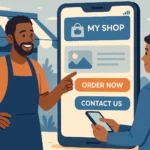Top Digital Marketing Trends Nigerian Businesses Should Know
The digital marketing landscape is always evolving, and as a Nigerian business owner or marketer, you’ll want to leverage the latest trends to stay competitive. But “trends” aren’t just buzzwords – they reflect shifts in consumer behavior and technology. In this conversational rundown, we’ll highlight some of the top digital marketing trends that Nigerian businesses should be aware of (and why they matter). Consider this a friendly briefing on what’s hot (and becoming standard) in 2025 for our market, with practical insights on how you might apply these trends to your own marketing strategy.
1. Mobile-First Marketing is a Must
What’s happening: Nigeria is an overwhelmingly mobile market. About 84–86% of our web traffic comes from mobile devices, one of the highest in the world. “Mobile-first marketing” means assuming your customer’s primary screen is their phone – so everything from your website design to your emails to your ads should be optimized for small screens and quick interactions.
Implication: Businesses are ensuring their websites are not just responsive, but super speedy on phones. Google’s been rewarding mobile-friendly sites in SEO rankings for years. In marketing campaigns, vertical video and thumb-friendly content (like Instagram Stories and TikTok videos) are front and center. Even simple things—like checking if your email newsletters read well on a phone, or if your product images load fast on slower connections—can significantly impact conversion rates.
Action tip: Audit your online presence from a mobile perspective. Test your site on various devices, use Google’s Mobile-Friendly test, and preview any digital ads on a 5-inch screen to ensure text and CTAs are clear.
2. Video and Interactive Content Dominate Attention
What’s happening: Video content—short social clips to longer series—has exploded in Nigeria as data becomes more affordable and 4G/5G coverage grows. Nigerians spend over 3 hours daily on social media, much of it watching video. Interactive formats like polls, quizzes, and AR filters are also trending because they actively engage users.
Implication: Brands are investing in video marketing through ads, live streams, webinars, and behind-the-scenes clips to build authenticity and trust. Interactive elements like polls and quizzes boost engagement and feed social algorithms.
Local example: Nigerian influencers and businesses have leveraged TikTok trends and interactive radio-social integrations, while sectors like banking use skits and explainers with celebrities to make their message stick.
Action tip: Start small: turn a blog post into a video summary, film customer testimonials, or run a poll asking “Which product should we launch next?” Use user-friendly tools like Canva or InShot.
3. Influencer Marketing Keeps Evolving
What’s happening: Influencer marketing has matured in Nigeria. Brands now favor long-term partnerships and micro-influencers whose loyal followers drive authenticity and measurable results.
Implication: Collaborate with niche influencers aligned with your brand values, consider performance-based deals (affiliate/referral codes), and focus on genuine recommendations over one-off celebrity posts.
Action tip: Identify influencers with real engagement, start small with reviews or giveaways, and allow them creative freedom to maintain authenticity.
4. Chatbots and Conversational Marketing
What’s happening: AI-powered chatbots and automated messaging on platforms like WhatsApp and Facebook Messenger handle inquiries, qualify leads, and provide instant information 24/7.
Implication: Quick responses via chatbots improve customer satisfaction and reduce friction. Advanced bots can answer FAQs, take orders, and even understand local language nuances.
Action tip: Implement basic Q&A flows using tools like ManyChat, Tidio, or WhatsApp Business API. Always include an option to escalate to a human agent.
5. AI and Machine Learning in Marketing
What’s happening: Beyond chatbots, AI tools power content creation, predictive analytics, and automated ad targeting. Marketers use AI to optimize send times, personalize website content, and generate copy drafts.
Implication: AI enables scalable personalization—showing different homepage products based on user behavior or sending tailored email recommendations—driving higher relevance and conversions.
Action tip: Experiment with AI for content brainstorming (e.g., Copy.ai), use platform-built machine learning features (like lookalike audiences), and critically review AI outputs to maintain your brand voice.
6. Social Commerce and “Shoppertainment”
What’s happening: Social media platforms now offer in-app shopping experiences (“social commerce”) and live-streamed sales events (“shoppertainment”), blending entertainment with purchasing.
Implication: Retailers can tag products in posts, create live selling events, and shorten the purchase funnel by letting customers buy without leaving the app.
Action tip: Enable Facebook/Instagram Shops, integrate with your e-commerce catalog, and host a live sales event to test real-time engagement and impulse buying.
7. Local Targeting and Hyperlocal Marketing
What’s happening: Hyperlocal marketing targets audiences by vicinity or community with tailored messages, resonating more strongly than generic national campaigns.
Implication: Geo-targeted ads and localized content (mentioning city-specific quirks or language) yield higher relevance and engagement from local consumers.
Action tip: Use Facebook’s radius targeting or Google My Business, segment email lists by location, and reference local events or seasons in your messaging.
8. Data Privacy and User Trust
What’s happening: With regulations like Nigeria’s NDPR/NDPA and global privacy shifts (phasing out third-party cookies), consumers demand transparency and control over their data.
Implication: Treat data as a privilege—obtain explicit consent, provide opt-outs, and highlight privacy protections to build trust and comply with regulations.
Action tip: Review your data practices, add a simple cookie consent banner, and focus on growing first-party data through voluntary sign-ups and value-driven lead magnets.
9. Content Marketing and Storytelling Remain Powerful
What’s happening: Quality content and storytelling stand out amid information overload. Engaging narratives build emotional connections and authority.
Implication: Brands that provide valuable, localized content—blog posts, videos, infographics—earn trust and drive long-term engagement.
Action tip: Share customer success stories, founder narratives, and how-to guides tailored to Nigerian contexts. Mix educational content with cultural moments to resonate deeply.
10. Automation and Marketing Tech Integration
What’s happening: Marketing automation—from email drip campaigns to CRM integrations—streamlines repetitive tasks and ensures consistent engagement.
Implication: Automation enables small teams to execute sophisticated campaigns around the clock, recovering abandoned carts and nurturing leads without manual effort.
Action tip: Implement a basic drip series with your email service, schedule social posts in advance, set up quick replies in messaging apps, and consider an affordable CRM to track and follow up leads.
These trends can sound like a lot to keep up with, but you don’t need to adopt them all at once. Stay informed and choose what aligns with your audience and goals. With Nigeria’s young, digitally savvy population, riding these trends will help you capture this dynamic market.
One more overarching point: customer experience is the heart of all these trends. Whether it’s making content more engaging, buying more convenient, or communication more personal, the winners will be those that genuinely serve and delight customers. As you try new strategies, monitor feedback and performance to refine your approach.
Happy marketing – no condition is permanent, including the digital landscape, so keep innovating! 😄





